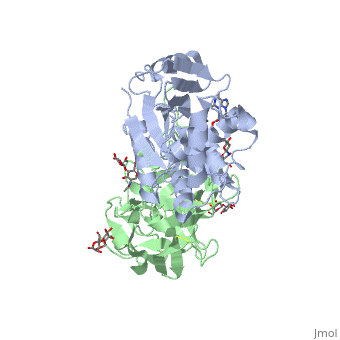From Proteopedia
proteopedia linkproteopedia link Ricin
| Found inside of the seeds of the castor oil plant and in castor beans, the cytotoxin, Ricin, is known to be one of Earth's most toxic proteins. Ricin was officially discovered in the year 1888 during the investigation of castor seed toxicity, which had been a mystery to scientists since their observations of its effects in the late nineteenth century. German scientist, Peter Hermann Stillmark, was able to extract this compound from the castor seed and purify it into the structure we see today. Originally thought to be used in aiding cancer patients, its highly toxic nature to humans deemed it too dangerous to use in a medical setting. Doctors and scientists have even worked together to pick apart the protein and use each chain in cancer therapy separately. On the other hand, it’s toxicity attracted the attention of criminals, military, and terrorists who came up with the idea of using it as a weapon in bio-terroristic attacks. [1] or to the article describing Jmol [2] to the rescue.
Toxicity
Structure
Mechanism of Action
Ricin Poisoning: Symptoms
Ricin Poisoning: Treatment
This is a sample scene created with SAT to by Group, and another to make of the protein. You can make your own scenes on SAT starting from scratch or loading and editing one of these sample scenes.
|
References
Audi J, Belson M, Patel M, Schier J, Osterloh J. Ricin Poisoning: A Comprehensive Review. JAMA. 2005;294(18):2342–2351. doi:10.1001/jama.294.18.2342
Etimad, L., Moshiri, M., & Hamid, F. (2019, June 6). Ricin: An ancient story for a timeless plant toxin. RBMB. Retrieved April 23, 2022, from https://www.ncbi.nlm.nih.gov/pmc/articles/PMC6628454/#sec2-toxins-11-00324title
Gal, Y., Mazor, O., Falach, R., Sapoznikov, A., Kronman, C., & Sabo, T. (2017). Treatments for Pulmonary Ricin Intoxication: Current Aspects and Future Prospects. Toxins, 9(10). https://doi-org.proxy.library.maryville.edu/10.3390/toxins910031
Tumer, N. E. (2019). Introduction to the Toxins Special Issue “Ricin Toxins.” Toxins, 12(1). https://doi-org.proxy.library.maryville.edu/10.3390/toxins12010013/

